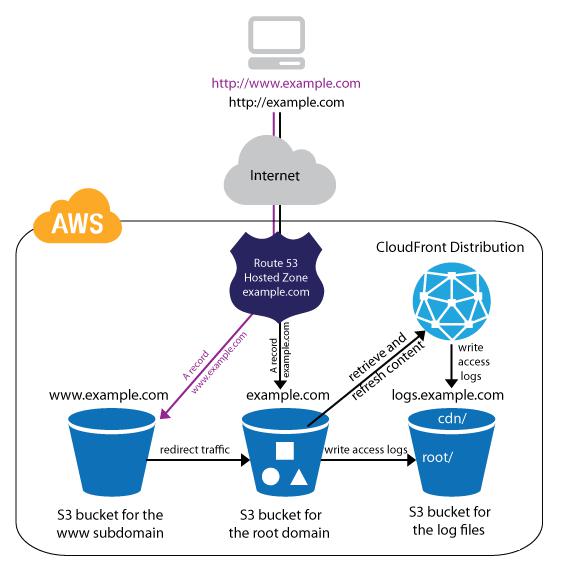Which of the following architectures can provide the most cost-effective and fastest loading experience?
A solutions architect is instructed to host a website that consists of HTML, CSS, and some Javascript files. The web pages will display several high-resolution images. The website should have optimal loading times and be able to respond to high request rates.
Which of the following architectures can provide the most cost-effective and fastest loading experience?
A . Host the website using an Nginx server in an EC2 instance. Upload the images in an S3 bucket. Use CloudFront as a CDN to deliver the images closer to end-users.
B . Host the website in an AWS Elastic Beanstalk environment. Upload the images in an S3 bucket. Use CloudFront as a CDN to deliver the images closer to your end-users.
C . Upload the HTML, CSS, Javascript, and the images in a single bucket. Then enable website hosting. Create a CloudFront distribution and point the domain on the S3 website endpoint.
D . Launch an Auto Scaling Group using an AMI that has a pre-configured Apache web server, then configure the scaling policy accordingly. Store the images in an Elastic Block Store. Then, point your
instance’s endpoint to AWS Global Accelerator.
Answer: C
Explanation:
Amazon S3 is an object storage service that offers industry-leading scalability, data availability, security, and performance. Additionally, You can use Amazon S3 to host a static website. On a static website, individual webpages include static content. Amazon S3 is highly scalable and you only pay for what you use, you can start small and grow your application as you wish, with no compromise on performance or reliability.
Amazon CloudFront is a fast content delivery network (CDN) service that securely delivers data, videos, applications, and APIs to customers globally with low latency, high transfer speeds. CloudFront can be integrated with Amazon S3 for fast delivery of data originating from an S3 bucket to your end-users. By design, delivering data out of CloudFront can be more cost-effective than delivering it from S3 directly to your users.

In the scenario, Since we are only dealing with static content, we can leverage the web hosting feature of S3. Then we can improve the architecture further by integrating it with CloudFront. This way, users will be able to load both the web pages and images faster than if we hosted them on a webserver that we built from scratch.
Hence, the correct answer is: Upload the HTML, CSS, Javascript, and the images in a single bucket. Then enable website hosting. Create a CloudFront distribution and point the domain on the S3 website endpoint.
The option that says: Host the website using an Nginx server in an EC2 instance. Upload the images in an S3 bucket. Use CloudFront as a CDN to deliver the images closer to end-users is incorrect. Creating your own web server to host a static website in AWS is a costly solution. Web Servers on an EC2 instance are usually used for hosting applications that require server-side processing (connecting to a database, data validation, etc.). Since static websites contain web pages with fixed content, we should use S3 website hosting instead.
The option that says: Launch an Auto Scaling Group using an AMI that has a pre-configured Apache web server, then configure the scaling policy accordingly. Store the images in an Elastic Block Store. Then, point your instance’s endpoint to AWS Global Accelerator is incorrect. This is how we serve static websites in the old days. Now, with the help of S3 website hosting, we can host our static contents from a durable, high-availability, and highly scalable environment without managing any servers. Hosting static websites in S3 is cheaper than hosting it in an EC2 instance. In addition, Using ASG for scaling instances that host a static website is an over-engineered solution that carries unnecessary costs. S3
automatically scales to high requests and you only pay for what you use.
The option that says: Host the website in an AWS Elastic Beanstalk environment. Upload the images in
an S3 bucket. Use CloudFront as a CDN to deliver the images closer to your end-users is incorrect.
AWS Elastic Beanstalk simply sets up the infrastructure (EC2 instance, load balancer, auto-scaling
group) for your application. It’s a more expensive and a bit of an overkill solution for hosting a bunch of
client-side files.
References:
https://docs.aws.amazon.com/AmazonS3/latest/dev/WebsiteHosting.html https://aws.amazon.com/blogs/networking-and-content-delivery/amazon-s3-amazon-cloudfront-a-match-made-in-the-cloud/
Check out these Amazon S3 and CloudFront Cheat Sheets: https://tutorialsdojo.com/amazon-s3/ https://tutorialsdojo.com/amazon-cloudfront/
Latest SAA-C03 Dumps Valid Version with 400 Q&As
Latest And Valid Q&A | Instant Download | Once Fail, Full Refund

